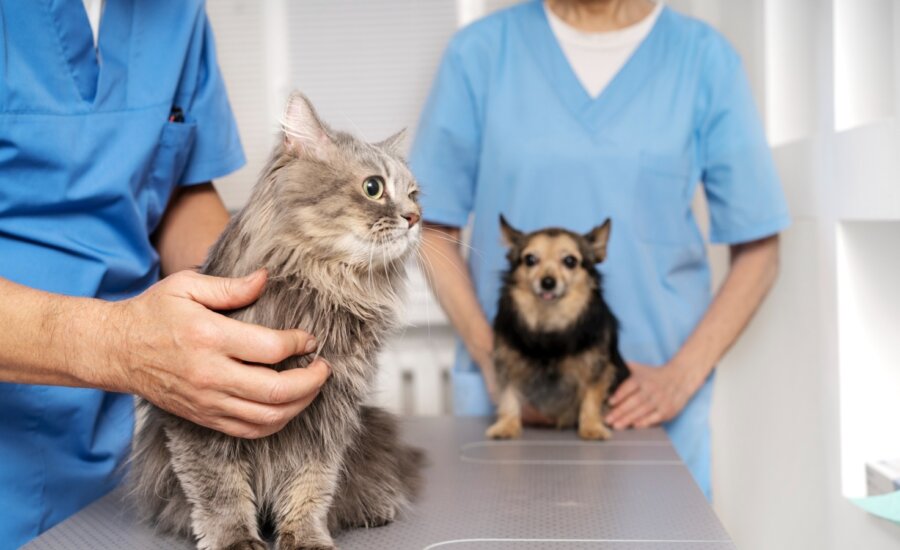Why are vets so expensive?
The costs of keeping the family pet healthy have outpaced inflation in Canada. We look at why it’s happening and steps you can take to save.
Advertisement
The costs of keeping the family pet healthy have outpaced inflation in Canada. We look at why it’s happening and steps you can take to save.

With more than half of Canadian households having a dog or a cat, or both, we are a nation of people who love their pets. They might break your favourite plant pot, tear a lampshade during a game of kitten parkour or occasionally pee on the floor, but they make up for it with cuddles, hilarity and unconditional love.
The joys of these animal companions, however, don’t come cheap: pet care costs have increased 6% to 8% annually over the past few years. On average, dog owners spend between $965 and $4,020 per year on their pup, while cat owners have it a little easier, at between $930 and $2,400 per year, according to pet-sitting app Rover. Between vaccinations, spaying/neutering, routine check-ups, and illness or emergencies, the costs of vet visits can start to rival your mortgage payments.
While inflation has had an impact on pet-care costs—as it has on virtually everything else we pay for in life—it’s not the only factor at play. The landscape of veterinary care has changed in recent years, largely thanks to staff shortages, the involvement of big corporations—in recent years, many independent clinics have sold to private equity firms—and increasingly sophisticated equipment and treatments. Here’s why you’re paying through the nose to keep your beloved four-legged friend healthy—and how you can reduce those costs a little.

There’s a lot that goes into animal health care. If your pet has been injured or simply isn’t feeling well—they’re uncharacteristically lethargic, say, or not interested in food—a battery of tests may be required to pinpoint the issue and determine care. X-ray and ultrasound machines, lab equipment and other vet tools have become more advanced in recent years, and as clinics invest into them, they have to charge more to recoup those costs.
Treatments can be pricey as well. Thanks to our publicly funded health care system, Canadians aren’t used to being confronted with the costs of medical care, so a several-thousand-dollar bill for chemo or surgery for your golden retriever can be a shock. But treatments for animal illnesses are often the same or very similar to human ones, so the costs are similar, too. Supply chain disruptions, coupled with a limited number of drug distributors, have led to higher medication prices as well.
And, like everyone else in the country, vets have seen their expenses rise due to inflation. Rents are higher, as are interest rates on loans, property taxes, insurance, utilities and maintenance fees. Vet businesses are feeling the pinch just like the rest of us, and they need to cover their basic running costs.
Another issue is staff shortages. There were barely enough veterinarians and veterinary technicians to go around pre-2020. Then, during COVID-19 lockdowns, pet ownership shot up, leaving many clinics struggling to cope with patient demand. There’s hot competition for potential staff, and one way to lure new talent is by offering higher compensation—that cost often gets passed on to pet parents. Let’s not forget there are clinic support workers who keep everything going, such as receptionists and cleaners; they need fair compensation, too.
One of the biggest factors in the increase in vet bills is that many clinics have been bought up by large corporations over the past few years at surprisingly high prices—sometimes as much as 30 times the clinic’s annual sales. These corporations tend to be more driven by profit than independent clinics and often pressure vets to increase billing or rates so they can plump up their investment. As well, with the high interest rates of the past two years, their new acquisitions have been costing them more than they anticipated, adding even more impetus to raise fees.
Watch: Is pet insurance worth it?
“An ounce of prevention,” well, you know the rest. It’s easy to just not worry about your pet’s health if they seem fine and happy, but being proactive now could save you a hefty bill down the road. Ensuring they eat healthy, get plenty of exercise and all the necessary shots and routine check-ups could help you prevent illness—or catch it at an early stage—and avoid potentially expensive treatments.
Be sure to shop around animal clinics before settling on where to take your pet. Rates can vary significantly, so it’s worth calling several spots to compare prices. Such differences aren’t necessarily random—the fees might include different things, such as bloodwork and pain medication, and some clinics have newer or better equipment or just pay higher rent. There are also lower-cost spay/neuter and vaccination facilities that offer a more basic (but still safe and adequate) service.
Something worth considering is pet insurance. Only 3% of Canadian cat and dog owners buy it, which could be due to the high costs of insuring a pet. Yes, pet insurance is expensive, but it could save you thousands if your pet does get a serious illness or injury. No one wants to have to choose between euthanizing a cat or dog and forking over their human kid’s education savings.
Some clinics offer options like payment plans, allowing you to spread out payments over a period of time. Or, if you’re really in a jam, look into local charities or support programs that offer financial help to those who can’t afford their vet bills; your vet may be able to connect you with one.
The bottom line is that pet ownership generally comes with unexpected veterinary costs, so it’s wise to be prepared for that. Our furry friends bring so much to our lives; the least we can do is ensure they stay as healthy as possible.
Share this article Share on Facebook Share on Twitter Share on Linkedin Share on Reddit Share on Email
I have worked in the field as a Vet Tech for 40yrs. The biggest change that affects the clients invoice is the advancement of patient care that is now the practice standard. An example of this is dental xrays that are now a necessity to practice within the standard of care. For years we performed dental exams without the aid of xrays. We didnt have equipment to do this. Now we do and the quality of patient care is higher. It is no longer acceptable to not xray. The client pays for the service. I remember the bygone days of everyone affording a pet and offering basic level care. I dont see that ever coming back.